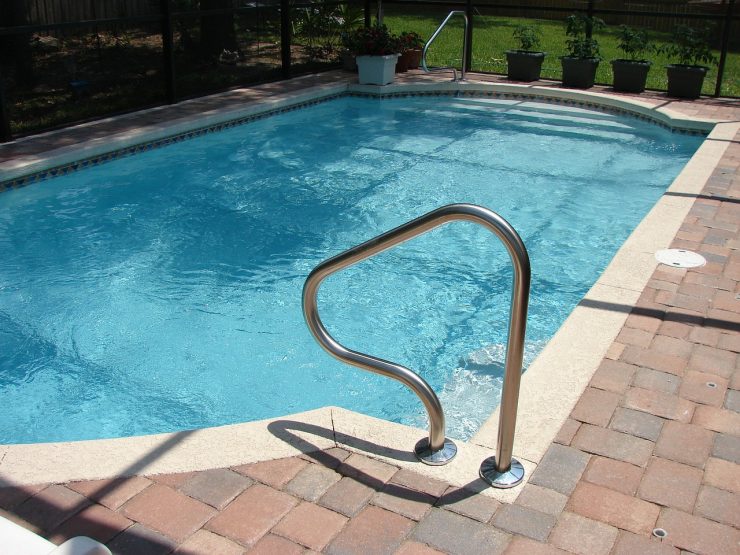A DE (diatomaceous earth) filter gives your pool a deeper clean than a sand or cartridge filter. But, if there is damage to the filter grids, DE powder can escape and will settle on the pool floor causing unsafe swimming conditions.
So, the question now is, how do you remove the excess?
To remove DE powder from the pool floor, vacuum up the powder using the “waste” setting on your filter. DE powder on the bottom of the pool indicates a problem with the filter, like damaged filter grids, or you may have added too much DE.
Before we dive into the exact steps of how to remove the extra DE powder from your pool floor, let’s find out possible reasons why the powder is there in the first place and how to prevent it.

Article Contents
Why is There DE on the Pool Floor?
The most common reason for DE powder settling on your pool floor is damaged filter grids. DE Grids can wear and tear over time, creating holes for the powder to pass through the filter and into the pool. You may also have added too much DE to the filter.
DE filter grids usually last 4-5 years before needing replacement, depending on how busy your pool gets. Over its lifespan, small cracks and tears can appear in the grid, causing the powder to bypass the filter and leak into the pool.
Luckily, you only need to replace the broken grid and not the entire assembly.
Aside from damaged grids, other possible causes of DE returning to the pool include:
- Cracks in the top manifold
- Damaged manifold pipe
- Broken standpipe
- Adding too much DE
- Spider gasket in the multiport valve
So, when you’re inspecting the filter for signs of damage, don’t forget to look at the entire filter assembly as well as the grids.
- Further Reading: Too Much DE Added to Filter (How to Remove Excess DE)
How to Prevent DE on Pool Floor
The easiest way to prevent DE from returning to your pool floor is to correctly measure the amount of DE when refilling. Also, regularly inspect your filter for damage and cracks. Inspect the internal components and deep clean them at least once yearly to keep them in top working condition.
Regularly checking the internal components of your filter will prevent the hassle of dealing with removing the settled DE powder.
Check the Multiport Valve and O-Rings
When you’re inspecting your filter, make sure to check o-rings (particularly the multiport valve spider gasket if you have one). As well as the top manifold and its pipe too.
- Contains 770 o-rings in 18 sizes
- Made of high-quality nitrile rubber
- Suitable for the leak repair of resist oils, hydraulic fluid, water, and abrasion
While the filter is apart, make sure to check for cracks along the top manifold for potential cracks by the ports and the manifold pipe connection. And, if needed, replace broken parts.
How your multiport valve (MPV) can be the culprit is during backwashing. Wear or tear of the spider gasket can cause some powder to leak into the Filter path during backwashing.
- Further Reading: How to Replace a Spider Gasket in Multiport Valve
So, even if your filter is in top condition, the MPV could be the cause of diatomaceous earth powder leakage. To prevent this from being the cause, regularly check the gasket for tears. And, make sure to turn off the pump when moving the MPV lever as, not doing so, increases wear on the gasket.
Is It Safe to Swim with DE Powder in Pool?

Although DE powder is more dangerous in dry form, it’s not safe to swim in a pool with settled powder on the pool floor.
The main danger of DE powder is when you’re handling it. Because of its chemical composition including high concentrations of silica, DE powder can cause respiratory issues and nasal passages if inhaled. It can also irritate the skin and eyes.
It’s worthy to note that DE powder is also a food supplement. However, there is a difference between pool-grade DE powder and food-grade. Pool-grade is further treated to harden diatom exoskeletons (to improve its filtration ability).
This added treatment increases the concentration of silica, which is extremely harmful to human and animal health. Make sure to only use food-grade DE powder if you’re curious about supplementing your diet.
Even though the excess powder settles on the pool floor, it’s not unusual for people to accidentally swallow pool water while swimming. And, therefore, could be swallowing DE as well.
If you insist on swimming while there is powder on the pool floor, stay in the deep end as this decreases your chances of swallowing DE-containing water.
When to Top Up or Refill DE Powder
The ideal time to top up or refill DE powder is after backwashing the filter and after a deep filter clean.
DE (Diatomaceous Earth), made of fossilized plankton, is the filter medium for this fine-sifting filter. It’s incredibly efficient at filtering out microscopic dirt and bacteria between 1-6 microns. To put that into context, a grain of salt is 100 microns.
For reference, sand filters only filter 20-40 microns and cartridge filters strain 5-20 microns. If you’re curious about which filter suits your needs best, check out our guide here: What’s the Best Pool Filter? Sand vs. Cartridge vs. DE
If you’re not needing to backwash or deep clean your filter, there is no need to top up or refill. Unfortunately, without a proper coat on the grids, dirt will easily pass through the filter, making your usual cleaning routine pointless. Plus, it can damage the filter itself.
How Often Should You Refill DE Powder in Filter
You should backwash your filter every 1 to 3 months to clean out old or lodged powder. And then, carry out a yearly deep clean to keep the filter working in top condition.
Backwashing is a mild clean and washes away old DE powder and any easily removed clumps.
And, because it’s not a thorough clean, there’s no need to add as much powder as a deeper clean needs (only about 80% of the recommended dose).
However, when you’re thoroughly cleaning the filter (dissembling to clean grids), you’ll need to fully refill it with powder. The needed dosage is the same for the initial setup or new installation.
How to Remove DE Powder From Pool Floor
The easiest solution to remove DE powder from your pool’s floor is to vacuum up all settled powder from the pool floor.
For the best results, use a manual vacuum (i.e. vacuum head attached to a telescopic pole) instead of an automatic pool cleaner. Many automatic vacuum users notice that the cleaner kicks up the powder rather than vacuuming it.
- For above-ground & in-ground swimming pools
- Nylon cleaning bristles
- Safe for use in vinyl-lined pools
So, once you’re ready:
- Turn off the pump and filter. This lets all the floating DE powder settle to the pool’s floor.
- Connect a hose to the vacuum and skimmer. Make sure air doesn’t trap in the hose when you put the vacuum head into the pool. Then, build up pressure in the vacuum by pumping the filter handle 2-3 times.
- Attach a second hose to the Waste valve port on the filter. Aim this hose towards your drain. As this is where most of the pool water will end up, check for any local water restrictions first.
- Turn Waste valve port to Backwash. Now, turn on the filter and vacuum slowly so you don’t kick up settled DE powder. It may be best to vacuum in sections to make sure you don’t leave any behind.
Tip: If you do stir up the DE, just wait 30-60 mins for it to settle on the pool floor, then vacuum again.
Following these steps will remove the excess DE easily.
Final Thoughts
Discovering a cloudy pool of DE powder is a pain for any pool owner. Unfortunately, the most likely culprit is because of the filter grids.
Luckily, the best solution to remove excess powder (after addressing the root cause) is to vacuum and it’s a simple process.
Related Reading: Why is There DE on my Pool Floor and Coming Out Jets?



